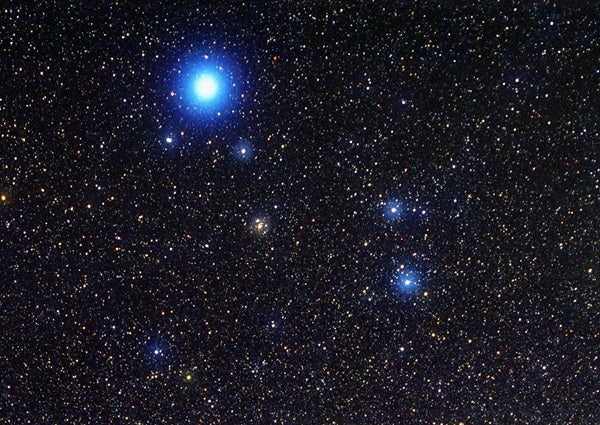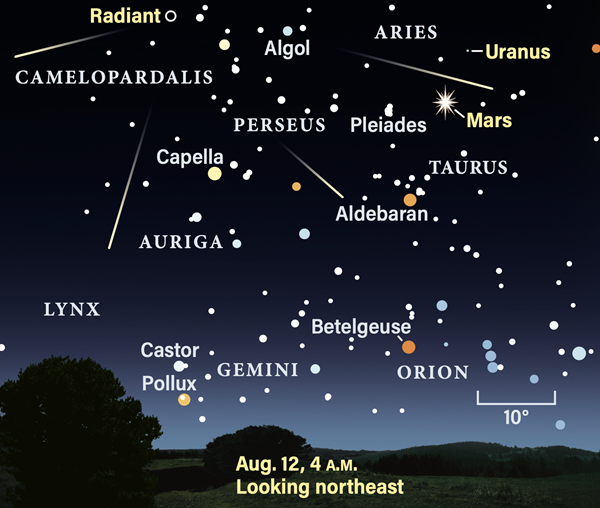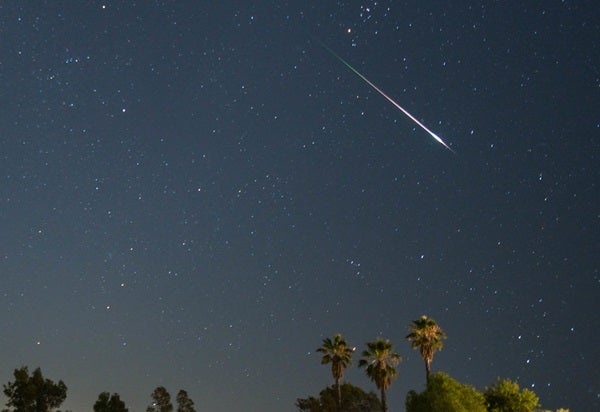Friday, August 5
First Quarter Moon occurs this morning at 7:07 A.M. EDT. Our satellite is quickly waxing toward Full — its entire face will be lit before the end of the week.
After dark tonight, Draco the Dragon curls around and on top of the Little Dipper in the north. This star pattern is the 8th largest of the 88 officially recognized constellations, covering 1,083 square degrees or nearly 3 percent of the sky. It is home to Thuban, a 4th-magnitude star that once sat above the North Celestial Pole of Earth as its Pole Star, instead of current-day Polaris. Now, Thuban sits some 26° from the pole, southwest of Polaris.
One easy pattern to find within Draco is the asterism of the Lozenge, outlined by four stars that mark Draco’s head. These stars are Rastaban, Eltanin, Grumium, and Al Rakis — also cataloged as Beta (β), Gamma (γ), Xi (ξ), and Nu (ν) Draconis, respectively. Eltanin is the brightest of these four at magnitude 2.2 Additionally, Nu is a 5th-magnitude double star that is easy to split with binoculars or even your telescope’s low-power finder scope.
To draw the Lozenge, start at Gamma, which sits about 39° directly above Polaris in the sky around 10 P.M. CDT. Beta sits 4° north-northwest of Gamma, then move 3° north-northeast to Nu. Finally, Xi sits 3.5° northeast of Nu and 5.5° south of Gamma, where we started.
Sunrise: 6:02 A.M.
Sunset: 8:09 P.M.
Moonrise: 2:03 P.M.
Moonset: —
Moon Phase: Waxing gibbous (53%)
*Times for sunrise, sunset, moonrise, and moonset are given in local time from 40° N 90° W. The Moon’s illumination is given at 12 P.M. local time from the same location.
Saturday, August 6
The waxing Moon sits between the claws of Scorpius in the south this evening, so let’s look north instead for darker skies.
Bright Vega in Lyra sits high in the north this evening, shining at magnitude 0. This star will someday sit above Earth’s North Celestial Pole, as our planet wobbles slowly on its axis and shifts from pointing at Polaris to Vega.
But Vega is not our main target tonight — instead, we’re looking for what Astronomy columnist Phil Harrington calls “one of summer’s premiere carbon stars:” T Lyrae. Sometimes referred to as the Jewel in the Harp, this 8th-magnitude luminary shows off its deep red color as a result of the ample carbon in its atmosphere, which scatters blue and green light but lets red wavelengths shine through to reach us. To see T Lyrae, you’ll want larger binoculars or a small telescope. It sits just 2° southwest of Vega, amid a scattering of faint white stars. Harrington recommends aiming first at Vega, then shifting your view so that Vega sits in the northeast corner of your field of view. Then look across the starfield until you see T Lyrae’s crimson glow pop out.
Sunrise: 6:03 A.M.
Sunset: 8:08 P.M.
Moonrise: 3:17 P.M.
Moonset: 12:16 A.M.
Moon Phase: Waxing gibbous (64%)
Sunday, August 7
Venus passes 7° south of Pollux in Gemini the Twins at 6 A.M. EDT. You can catch the pair before sunrise in the east; an hour before the Sun peeks above the horizon, Venus is roughly 20° high, with golden-hued Pollux (magnitude 1.2) to its upper left. Through a telescope, Venus’ bright disk will appear nearly full — 94 percent lit — and 11″ across. The planet is moving east along the ecliptic relatively quickly and will cross into nearby Cancer within a few days. In less than two weeks, it will meet up with the stunning Beehive Cluster (M44).
Pollux is a star with nearly twice the mass of our Sun, but which is slightly cooler — albeit more luminous. It marks one of the Twins’ heads. Directly above Pollux is magnitude 1.6 Castor, the other Twin’s head. It is an easy-to-split double with a third companion just over 1′ away. Each of these stars is also double, meaning Castor is truly a sextuple system.
Despite the fact that Pollux is the brighter star, it is designated as Beta Geminorum, while Castor received the title of alpha.
Sunrise: 6:04 A.M.
Sunset: 8:07 P.M.
Moonrise: 4:32 P.M.
Moonset: 12:55 A.M.
Moon Phase: Waxing gibbous (74%)
Monday, August 8
The gas giant Saturn is nearing opposition, making now the best time to view its stunning ring system and many moons. Rising as the Sun sets, give Saturn an hour or two to climb away from the horizon. By about 10 P.M. local time, Saturn is more than 15° high in the southeast; its altitude will continue to increase into the early morning, when it reaches its highest point above the horizon about an hour and a half after midnight.
Saturn sits in Capricornus, just 2° northwest of magnitude 2.9 Deneb Algedi. The ringed planet is currently magnitude 0.3 but will briefly brighten by 0.1 magnitude within a few days. Thought a telescope, its disk spans some 19″, while the rings — one of the most breathtaking sights in the solar system — are nearly 43″ across. Enjoy them while you can, as we’re lining up for a ring plane crossing, when the rings appear edge-on from Earth, in 2025.
Iapetus, which reached greatest western elongation yesterday, still sits 9′ west of the planet. The moon is also currently at its brightest, roughly 10th magnitude. One the other side of Saturn, Titan (magnitude 8.5) is 3′ east of the disk; both properties make it easier to spot, particularly in smaller scopes.
Sunrise: 6:05 A.M.
Sunset: 8:06 P.M.
Moonrise: 5:44 P.M.
Moonset: 1:43 A.M.
Moon Phase: Waxing gibbous (84%)
Tuesday, August 9
Mars, which started the month close to the distant ice giant Uranus in the sky, moves into Taurus today. Rising shortly after midnight, the Red Planet is visible all morning, with the best views coming in the few hours before sunrise, when it’s highest in the east. Glowing at magnitude 0.1, Mars is an easy naked-eye object. To view Uranus, which is magnitude 5.8, sweep binoculars or a telescope just over 5° west of Mars into Aries to search for its blue-gray disk.
This morning, Mars floats 8.5° southwest of the brilliant Pleiades star cluster, a favorite of naked-eye and telescopic observers alike. About 16.5° east of Mars is red-hued Aldebaran, a red giant star that marks the eye of the Bull as he’s drawn on the sky. It sits among — but is not part of — another famous star cluster, the Hyades.
Mars will continue through Taurus during August, following a path that will take it between the Pleiades and Hyades. By contrast, more distant Uranus will remain in roughly the same patch of sky all month, appearing to move much more slowly against the background stars.
Sunrise: 6:06 A.M.
Sunset: 8:04 P.M.
Moonrise: 6:47 P.M.
Moonset: 2:43 A.M.
Moon Phase: Waxing gibbous (92%)
Wednesday, August 10
Although it’s still two days before the Perseid meteor shower officially peaks, meteor-watchers will find prospects better this morning than on Friday. That’s because while the bright Moon will dominate the predawn sky later this week, today the Moon sets just before 4 A.M., leaving a good hour of dark skies available to catch shooting stars before twilight interferes.
By the time the Moon sets, the shower’s radiant in Perseus the Hero is nearly 60° high in the northeast. Although this is the point from which meteors will appear to originate, you’ll want to concentrate your search on either side of the radiant and slightly away from it, as meteor trains are longer the farther from the radiant they appear. The shower is ramping up to a maximum rate of 100 meteors per hour, so you can expect to see quite a few meteors under good conditions, even with a few days until the peak.
The Moon reaches perigee, the closest point to Earth in its orbit, at 1:09 P.M. EDT. At that time, our satellite will sit just 223,587 miles (359,828 kilometers) away. Its proximity sets the stage for a Super Moon tomorrow when Luna’s phase reaches Full.
Sunrise: 6:07 A.M.
Sunset: 8:03 P.M.
Moonrise: 7:40 P.M.
Moonset: 3:54 A.M.
Moon Phase: Waxing gibbous (97%)
Thursday, August 11
Full Moon occurs at 9:36 P.M. EDT. August’s Full Moon is also called the Sturgeon Moon; because the Full Moon occurs shortly after our satellite reached perigee, this month’s Full Moon is also classified as a Super Moon, which will appear particularly big and bright. It’s the fourth Super Moon in a row this year and the last such event in 2022.
When it is Full, the Moon rises roughly at sunset and sets around the time the Sun rises. These are both particularly good times to view the so-called Moon illusion, which causes the Moon to look bigger near the horizon and smaller when near zenith in the sky. Although the Moon is not really bigger when it’s rising than when it’s transiting, it is of course slightly (apparently) larger than usual tonight because of the Super Moon effect.
The Full Moon is in eastern Capricornus, not far from the planet Saturn. In fact, the Moon will pass 4° due south of Saturn at midnight EDT and remain in the vicinity of the ringed planet through dawn on the 12th.
Sunrise: 6:08 A.M.
Sunset: 8:02 P.M.
Moonrise: 8:22 P.M.
Moonset: 5:13 A.M.
Moon Phase: Full
Friday, August 12
The Perseid meteor shower peaks today under a still nearly Full Moon, which will unfortunately wash out all but the brightest meteors. Nonetheless, it’s worth stepping outside before twilight starts to light the sky to see if you’ll get lucky and spot a fireball or two. Because the Perseids are an active shower (remember that predicted maximum rate of some 100 meteors per hour), you can expect that some brighter meteors will occur and you may catch them, even with the Moon interfering. Remember that the radiant will be high in the northeast before dawn — scroll up to our entry for the 10th to check out a chart showing the radiant and surrounding sky at that time.
The dust trail Earth is traveling through to generate the shower is composed of debris left behind by Comet 109P/Swift-Tuttle, which circles the Sun every 133 years. Its last passage through the inner solar system was in 1996.
Sunrise: 6:09 A.M.
Sunset: 8:01 P.M.
Moonrise: 8:57 P.M.
Moonset: 6:32 A.M.
Moon Phase: Waning gibbous (99%)













